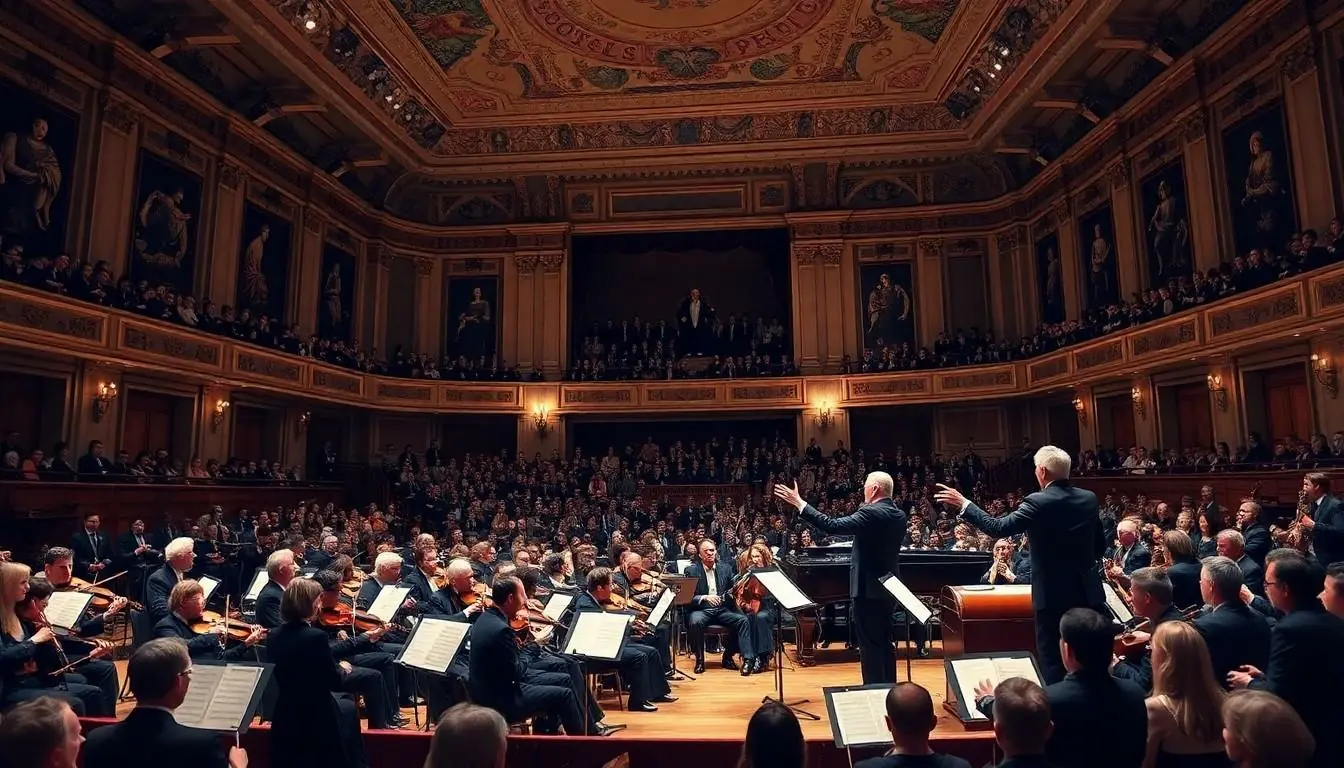Picture this: oversized tees, baggy jeans, and sneakers so fresh they practically scream, “I’m ready to breakdance!” The 90s hip hop scene birthed a fashion revolution that still resonates today. Streetwear for men during this era wasn’t just clothing; it was a statement, a culture, and a way to show off individuality while keeping it real.
Table of Contents
ToggleOverview of Streetwear Male 90s Hip Hop Fashion
Streetwear male 90s hip hop fashion defines a unique blend of comfort and style, rooted deeply in urban culture. Baggy jeans became a staple, favored not only for their fit but also for their association with freedom and self-expression. Oversized tees adorned with bold graphics and logos frequently appeared on the scene, signaling a break from traditional fashion norms.
Sneakers played a crucial role, as brands like Nike and Adidas dominated the trends. High-top sneakers, often worn with vibrant colors, added a dynamic flair to outfits. Accessories such as bucket hats and gold chains complemented the overall look, enhancing the vibe that was so characteristic of the 90s hip hop scene.
Iconic figures like Tupac Shakur and The Notorious B.I.G. influenced countless fans, solidifying their styles as collective symbols of their communities. Streetwear not only embraced elements of sportswear but also incorporated styles from various subcultures, making it eclectic and diverse. The influence of skate culture introduced plaid flannel shirts and skate shoes into the mix, exemplifying the crossover between different street styles.
Brands like FUBU and Karl Kani emerged, creating clothing lines that resonated with the hip hop culture while promoting a sense of identity. Commercial success followed as these brands became associated with the mainstream acceptance of hip hop. The 90s hip hop fashion era challenges the traditional views on masculinity, pushing boundaries and inspiring future generations of streetwear enthusiasts.
Key Influences

Several key influences molded the streetwear male 90s hip hop fashion scene. Music and art played significant roles in shaping styles and trends during this era.
Music and Art
Hip hop music revolutionized culture, providing a soundtrack that inspired fashion choices. Artists expressed their identities through bold visual designs, mirroring song themes in clothing. Graffiti art infused urban flair, influencing patterns seen on apparel. Album covers often showcased emerging fashion trends, promoting brand awareness and unique styles. Street art and music videos prominently featured oversized tees, baggy jeans, and sneakers, creating a visual connection between hip hop and fashion.
Icons of the Era
Prominent figures of the 90s defined the streetwear landscape through distinct styles. Tupac Shakur captivated audiences with his dynamic personality and fashion sense, popularizing bandanas and fitted caps. The Notorious B.I.G. presented an alternative aesthetic, favoring tailored suits paired with streetwear elements. Additionally, other artists like Nas and Snoop Dogg further diversified looks, cementing individual expression as paramount. Fashion brands embraced this influence, leading to collaborations that blended music and style, ultimately inspiring future generations.
Signature Styles
The 90s hip hop scene established several defining styles that shaped male streetwear. Each signature element contributed to the overall essence of the era.
Baggy Jeans and Cargo Pants
Baggy jeans emerged as a central piece of 90s hip hop fashion. Their loose fit provided comfort and freedom, resonating with the desires of urban youth. Cargo pants also gained popularity, characterized by large pockets, functionality, and relaxed silhouettes. Both styles became staples, signifying a break from the restrictive fits of previous decades. Fashion icons wore these bottoms, further cementing them as must-have items. Wearers embraced their adaptability, pairing them with various tops and sneakers to create unique looks.
Graphic Tees and Hoodies
Graphic tees defined the visual language of 90s hip hop fashion. Artists showcased bold graphics and slogans that expressed individuality and cultural pride. Hoodies, often oversized, offered comfort while providing a canvas for artistic designs. They became essential for layering, creating a relaxed yet stylish appearance. Styles varied from simple logos to intricate patterns, reflecting diverse influences from music and art. The combination of graphic tees and hoodies allowed wearers to convey personal statements while remaining true to the era’s urban roots.
Popular Brands
Streetwear from the 90s thrived on distinctive brands that shaped the fashion landscape.
FUBU and Sean John
FUBU emerged as a groundbreaking brand, representing the voice of hip hop culture. Founded in 1992 by Daymond John, FUBU captured the essence of street style with its oversized tees and baggy jeans. Sean John followed in 1998, launched by rapper Sean Combs. This brand emphasized urban luxury with sleek designs and high-quality materials. Both brands resonated deeply with fans, providing a sense of identity while celebrating cultural heritage. Success for FUBU and Sean John went beyond clothing, influencing how streetwear affected mainstream fashion trends.
Nike and Adidas Collaborations
Collaborations between Nike and Adidas during the 90s revolutionized sneaker culture. Athletic wear evolved into a style statement, with iconic models like the Air Jordan becoming symbols of status. Nike embraced partnerships with hip hop artists, infusing sneaker designs with creativity and urban flair. Adidas, with its Superstar and Shelltoe models, connected with the music scene, reinforcing cultural ties. Such collaborations not only showcased the brands’ adaptability but also heightened interest among streetwear enthusiasts. The impact on streetwear remains significant, with these sneakers still celebrated today for their blend of sport and style.
Legacy and Modern Impact
90s hip hop fashion greatly influenced contemporary streetwear, leaving a lasting legacy that still shapes styles today. Baggy jeans and oversized tees remain essential components in modern wardrobes, reflecting a prevailing preference for comfort and self-expression. Cultural icons from this era, such as Tupac Shakur and The Notorious B.I.G., continue to inspire designers and fans alike.
Iconic brands like FUBU and Sean John set the stage for future streetwear lines, blending urban aesthetics with commercial appeal. FUBU emphasized inclusivity, making it easier for individuals to embrace their cultural identities. Sean John brought urban luxury into the spotlight, showcasing how hip hop influences can elevate fashion trends.
Sneaker culture also underwent a transformation during the 90s, with collaborations between brands like Nike and Adidas leading to iconic styles that carried status and prestige. The Air Jordan became a symbol of achievement, influencing how sneakers are perceived in both fashion and lifestyle contexts.
Graffiti art intertwined with fashion, introducing unique designs that emphasized individual expression. Graphic tees featuring bold visuals and messages served as canvases for personal storytelling, reinforcing cultural pride and connections to urban communities.
Current streetwear brands often draw inspiration from this 90s aesthetic, integrating classic elements with modern twists. These designs evoke nostalgia while appealing to new generations seeking authenticity and heritage in their fashion choices. Cultural roots remain significant, with styles that once expressed rebellion now embraced in everyday life.
The essence of 90s hip hop fashion continues to resonate in today’s streetwear scene. Its blend of comfort and style laid the groundwork for a cultural movement that champions individuality and self-expression. Iconic elements like baggy jeans and oversized tees have transcended time, proving their enduring appeal.
As modern brands draw inspiration from this vibrant era, they honor the legacy of pioneers who shaped the landscape. The influence of music and art remains palpable, reminding enthusiasts of the power of fashion as a form of identity. This rich tapestry of style not only reflects the past but also inspires future generations to embrace their unique narratives through fashion.




